 THE UNION NAVY (“OLD NAVY”)
THE UNION NAVY (“OLD NAVY”)
The goal of this chapter is not to portray every single ship featured during the American Civil War (1861-1865), on the union side – it would be useless and time consuming. But rather we will try here to show the main classes and most important ship, of military or historical value, and the events they were involved in.
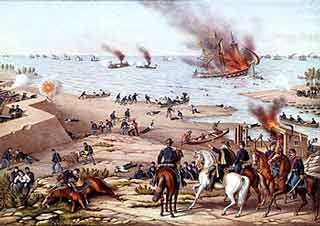
The Battle of Hampton Roads between the Monitor and the Merrimack, the first clash of ironclads in history.
The Union fleet through the territorial distribution of the states at war, and compared to the Confederacy, had the bulk of the industrial power of the continent, as well as major ports and arsenals of the East Coast. On paper, naval superiority of the Union was just overwhelming. A blocus, to deprive any exports from the Confederacy was a safe option, and indeed proved to be not a war winning strategy, but a crucial element to help achieve the Union’s goal.
So let’s see its composition: The U.S. Navy was born from a few ships built just after the American revolution, and still revered, like the famous frigates of the constitution class. During the second british-american war of 1812, this “fleet” was no match for the mighty Royal navy. Nevertheless, Fulton gave the congress a modern ship which was launched too late to be seen in action: The Demologos (see below).
Articles done and upcoming
- CSS David (1862)
- CSS Frederickburg (1862)
- CSS Savannah (1863)
- CSS Stonewall/Kōtetsu/Azuma (1864)
- HL Hunley (1863)
- Unadilla class gunboats (1861)
- USS Alligator (1862)
- USS Keokuk (1862)
- USS Monitor (1862)
- USS New Ironsides (1862)
- USS Spuyten Duyvil (1864)
Sailing Ships
USS Pennsyvania (120 guns) (1837)
USS Columbus (92 guns) (1819)
Delaware class (90 guns) (1820)
USS Vermont (90 guns) (1848, never completed)
Potomac class (11-54 guns) (1822-55)
USS Congress (50 guns) (1841)
USS Constellation (24 guns) (1855)
USS Cumberland (90 guns) (razee 1856)
USS Independence (54 guns) (razee 1836)
USS Macedonian (22 guns) (razee 1852)
USS United States (44 guns) (1798)
USS Constitution (38 guns) (1797)
16 Sailing sloops (extant 1860)
3 Sailing brigs (extant 1860)
monitors & armored ships
USS Galena (1862)
Passaic class
USS Roanoke
USS Onondaga
Miantonomoh class
USS Dictator
USS Puritan
Canonicus class
Kalamazoo class
Milwaukee class
Casco class
wooden screw Frigates
USS Franklin (1854)
Merrimack class (1855)
USS Niagara (1855)
Wampanoag class (1864)
USS Chattanooga (1864)
USS Idaho (1864)
Wooden screw Corvettes
USS San Jacinto (1850)
USS Brooklyn (1858)
USS Hartford (1858)
USS Lancaster (1858)
USS Richmond (1860)
USS Pensacola (1859)
wooden screw sloops
USS Alleghany (rebuilt 1851)
USS Princeton (1851)
USS Mohican (1859)
USS Iroquois (1859)
USS Wyoming (1859)
USS Dacotah (1859)
USS Narragansett (1859)
USS Seminole (1859)
USS Pawnee (1859)
USS Pocahontas (rebuilt 1859)
Ossipee class (1862)
USS Sacramento (1862)
Ticonderoga class (1862)
Gunboats
Kansas class (1862)
Octorara class (1862)
Sassacus class (1862)
Mohongo class (1863)
Side wheel vessels
Stevens Battery (1845)
USS Mississippi (1842)
USS Susquehanna (1850)
USS Powhatan (1850)
USS Saranac (1848)
USS Fulton (1837)
USS Michigan (1843)
USS Water Witch (1845)
USS Saginaw (1849)
USS Pulaski (purchased 1859)
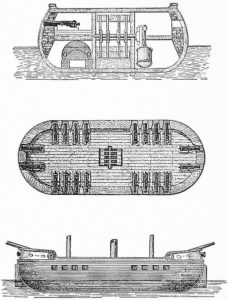 USS Demologos: This revolutionary ship was a steam-only, heavily protected gunboat. Only an unconventional warfare could be used against the might of the empire. So the congress let some privateers free hands against british shipping, using fast Baltimore schooners, with good successes, atlhough it was a Goliath against David fight. The war was won at land, eventually. But the lessons were learned by those who, in the confederacy, fifty years later, built the confederate fleet.
USS Demologos: This revolutionary ship was a steam-only, heavily protected gunboat. Only an unconventional warfare could be used against the might of the empire. So the congress let some privateers free hands against british shipping, using fast Baltimore schooners, with good successes, atlhough it was a Goliath against David fight. The war was won at land, eventually. But the lessons were learned by those who, in the confederacy, fifty years later, built the confederate fleet.
Between 1820 and 1861, hundred of gun armed steamships were built, and at the starting of the war, the bulk of the fleet was in Union hands, largely constituted of steam frigates and corvettes, and some ships of the line.
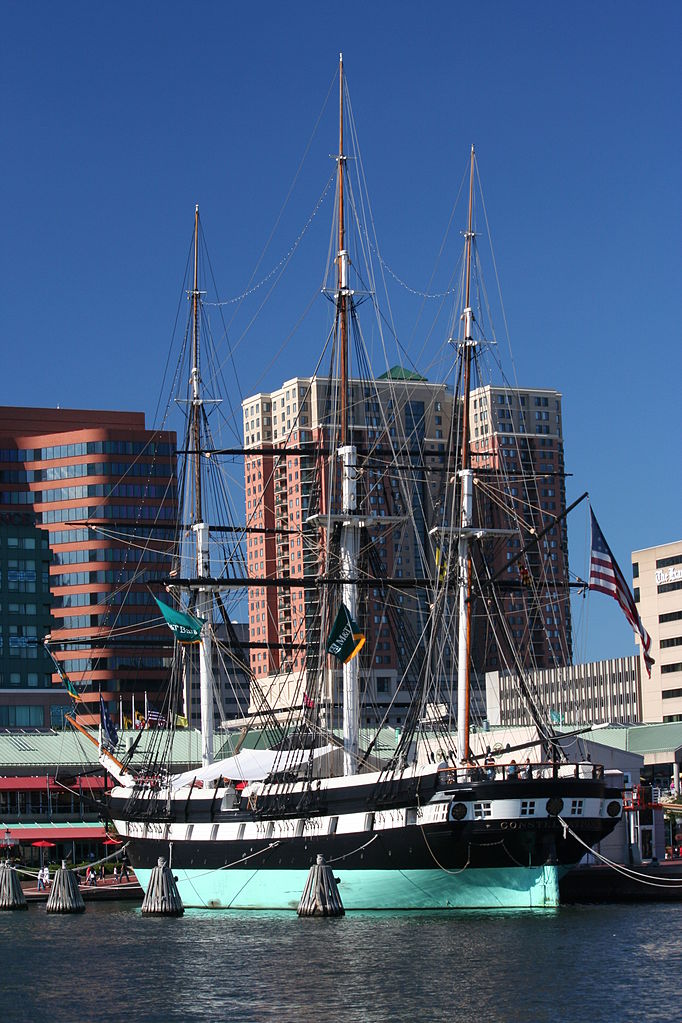
USS Constellation – Inner harbor Baltimore. These early 1797-1799 frigates became legendary.
Sailing vessels :
Ships of the line :
The most powerful ship of the fleet was the four-decker, first rate ship of the line USS Pennsylvania (1837), with 120 guns. USS Columbus followed (launched 1819) with 92 guns, then USS Delaware (1820) of 90 guns, and also New Hampshire, North Carolina and Ohio, all of the same class (the 90 guns or third rate was the common ship of the line at this time). Other three-deckers were ordered but never completed, New Orleans, New York, Vermont and Virginia.
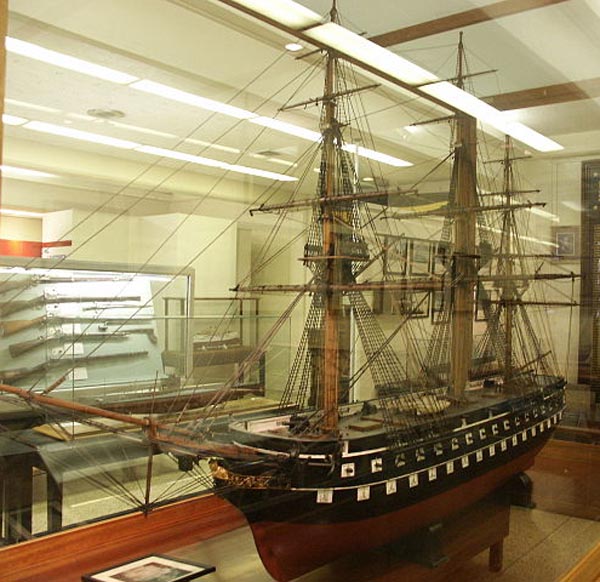
Model of the USS Delaware
Frigates and corvettes :
Amongst the numerous ships in service in 1860 the most famous were undoubtedly the USS Constitution and United States, dating from 1797 and 1798. These veterans of the 1812 war against the British carried the Stars and Stripes form the Mediterranean to China, and the Constitution ended as a legendary icon, so dear to the hearts of Americans than the Victory of the British, and naturally preserved in sea going conditions.
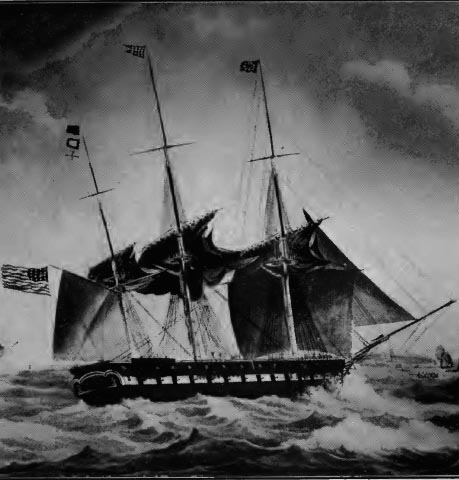
USS Brandywine 1831
Frigates
Most frigates built from 1820 were of a standard that could be almost dubbed as a “class”: The “50 guns, 1726 tons.” There were 6 in which the first one, USS Potomac, was launched in 1822 and the last, USS Santee, was being completed in 1861. There was also the USS Congress (50 guns) and the corvette USS Constellation (24). Three others were deprived of their masts, transformed into pontoons to serve as headquarters of the fleet: The USS Independence, and Cumberland and Macedonian, both of which are corvettes.
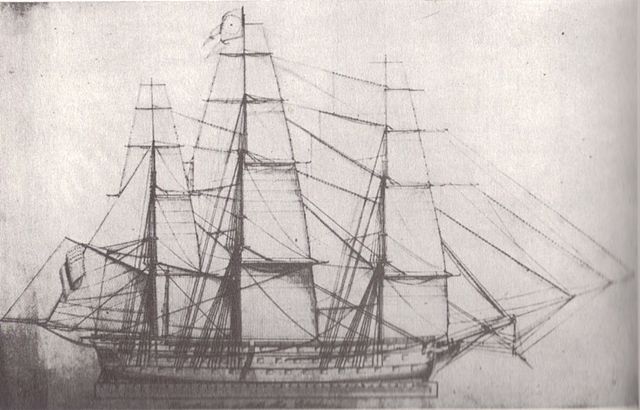
USS Columbus Master Sailmaker Plan
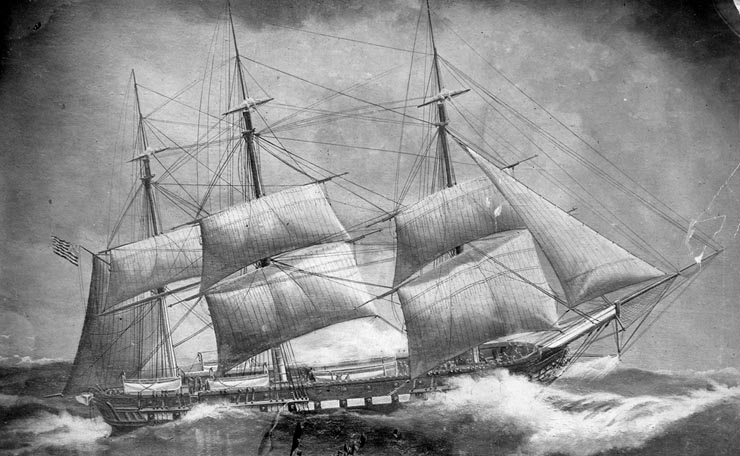
USS Congress 1841
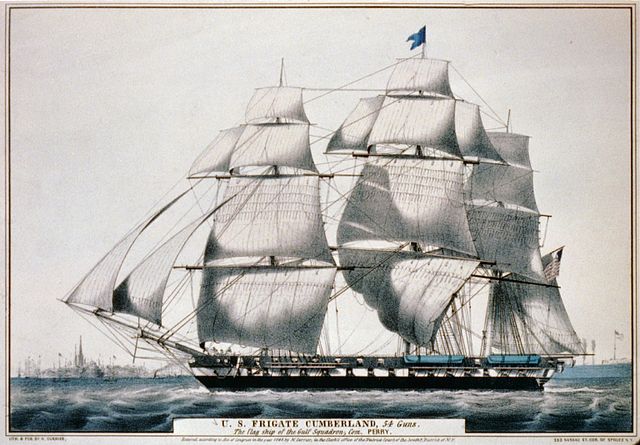
USS Cumberland
Eventually, the fleet also included the corvettes USS Cyane, Dale, Decatur, Germantown, and 12 other units, as well as bricks USS Bainbridge, Dolphin and Perry. They were fast, but lightly armed, more suited for dispatches and scouting or attacking British trade, than to be thrown in a classic naval battle. Most of them were used to blockade the confederacy ports and trade lines.
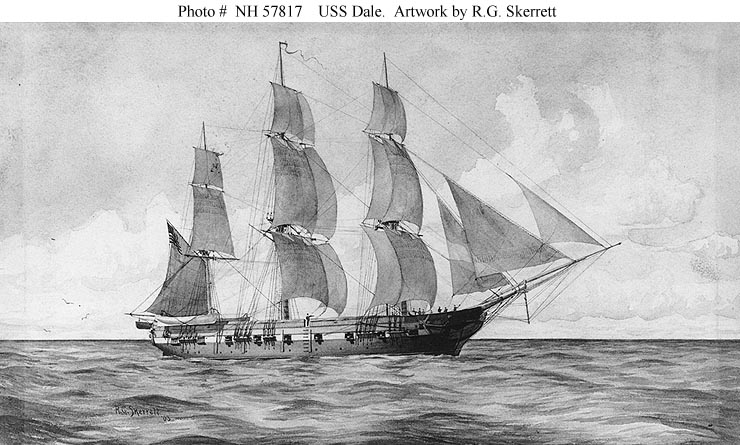
USS Dale 1839
Wartime shipbuilding (1861-65):
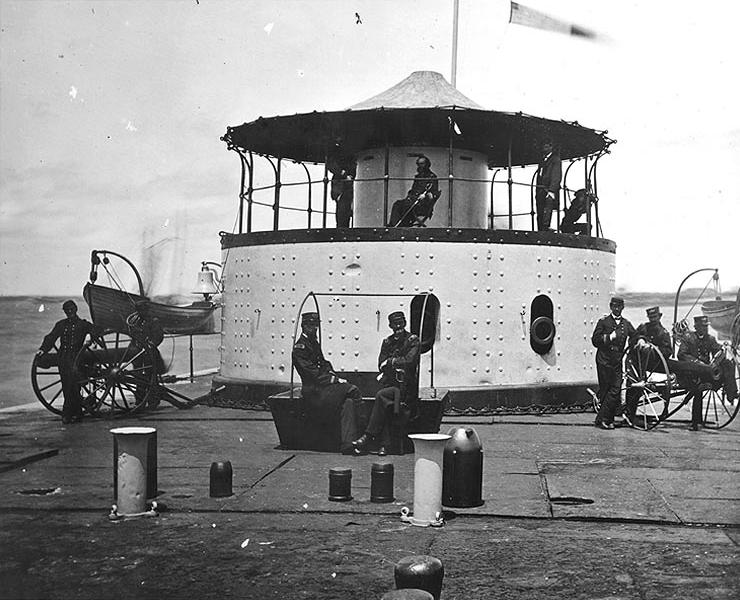
Officers on the bridge of USS Castkill
Ironclads and monitors :
The retooling of the Union Navy in specific units really began in 1862 with the USS Monitor, the first revolutionary steam ironclad. It gave rise to a family of riverine typically American ships, which northerners and southerners made great use on the Mississippi River and the James River, up to massive confrontations, real river battles of wooden ironclads.
The famous challenger of the USS Monitor, the CSS Virginia (Merrimack), was also a metal armoured ship, but not as revolutionary with its classical border, fixed artillery.
The only sailing ironclad built for the U.S. Navy at Cramp navy yard between 1861 and 1862 was the USS New Ironsides, comparable to European standards. The later USS Dunderberg was larger and better armed, the result of the experience of war, but came too late to participate in the conflict, and was sold to France two years later.
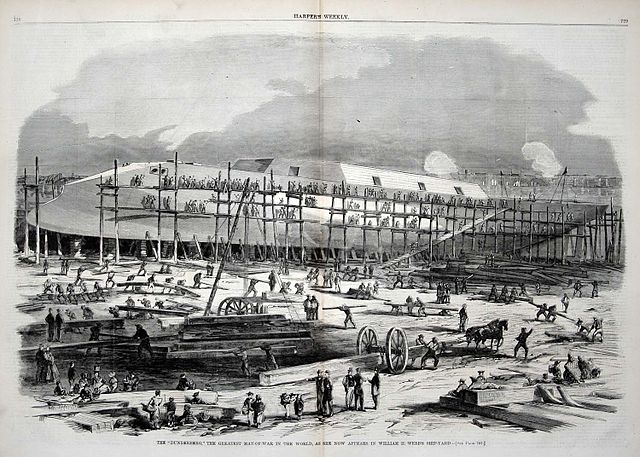
USS Dunderberg in construction at the end of the war. She integrated many lessons of the civil war at sea (cc)
But the real revolution was the commissioning of a very critical ship concept, inherited from radical idea of the swedish engineer Ericsson, but nonetheless strongly supported by Lincoln himself: The Monitor. It was designed to counter the threat of Confederate ironclad Merrimack, at this point without rival in the union fleet, and a powerful threat by itself. The monitor differed in their choices much more innovative approach, including a turret, an idea taken and perfected by the English Coles, and seen as bright future of guns handling.
The USS Monitor, operational in 1862, was followed by those of the Passaic class (1862-1863), 9 units strong. The tenth, USS Camanche, was completed too late to participate in naval operations. The following class, Monadnock, entered service too late to participate in the conflict, except the first in the series.
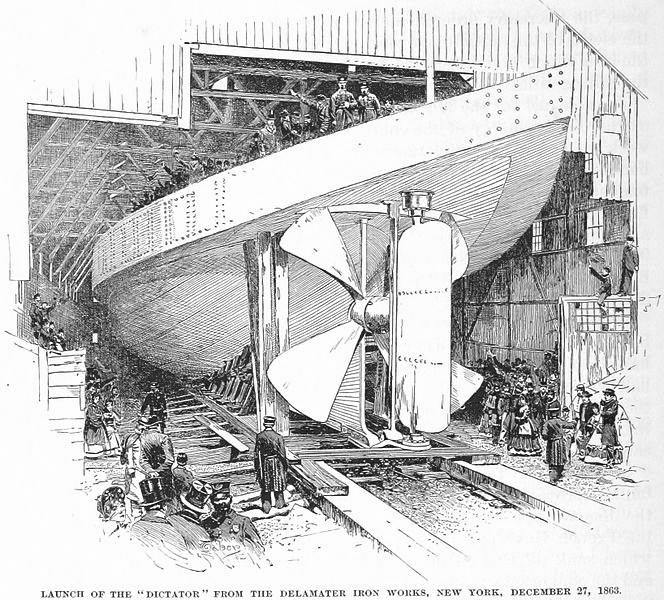
Launch of USS Dictator – Press illustration (cc)
Two large sea-going monitors were also built in 1863 and 1864, the USS Roanoke and Dictator. The Puritan, in the same class as that was never completed. Close to the Passaic, of the 9 Canonicus class, 5 became operational in 1864.
The construction of large Kalamazoo, or Monadnock class monitors, which began in 1863, was never completed. Eventually, four cheaper monitors of the Milwaukee class enterd current service in 1864, as well as nine other monitors of a cheap, prefabricated mass production of the Casco Class.
At the end, the sheer industrial capacities of the north prevailed. A a concept of a heavy-guns relatively small and riverine ship, the monitor lasted until 1914 in US navy service. The Royal navy built some sea-going modern equivalents to deal with specific objectives of the western, coastal front like the german defences in belgium, from the north sea. Two of them, modernised, were still in service in 1945.
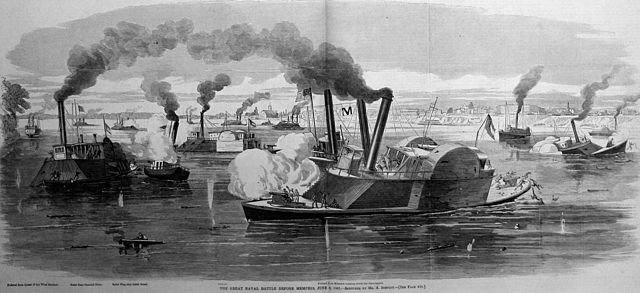
The riverine first battle of Memphis on the Tennessee, June 6, 1862, which was seen first hand by the inhabitants, fought be even forces od rams and protected paddle-wheelers and won by the Union
In fact, the “old navy” as it was called later, in 1890, was the product of the aging, if not completely obsolete collections of ships left of the Secession war. After the secession war, there was no need for a powerful fleet, and it was slowly reduced or forgotten by successive presidents, to the point that in 1885, the situation was a disaster.
Compared to, for example, the spanish fleet, at least on the paper, the US Navy was almost non-existent, a dull force. A new start was given in 1890, in order to adjust the fleet to the level of wealthiness and industrial resources of USA. Then, the “old navy” has ceased to exist, and in 1918, the US navy was rocketed to the second world rank, very close behind its arch rival, the Royal navy…
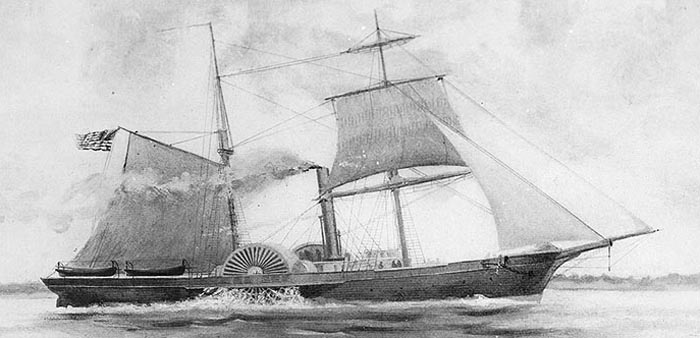
Paddle corvette USS Harriet Lane (1857). This ship became CSS Harriet Lane after being captured by the Confederates in 1863 during the Battle of Galveston and used for trade, until recaptured by the Union in 1865.
Nomenclature of Union Ships
As seen before, the union dwarfed easily the confederacy in terms of naval and industrial might. Union ships were mostly used to blockade the southern harbours and trade lines, notably to forbid all exports of cotton, many ships beeing given also the task to intercept cotton-loaded steamers and chasing condeferate corsairs along the war.
Until the end, the union built an amazing force of riverine gunboats, ironclads, and wheeled or screw patrol boats (like the “90 days schooners”), not to mention the revolutionary Monitor and its successors.
USS PENNSYLVANIA (1837)
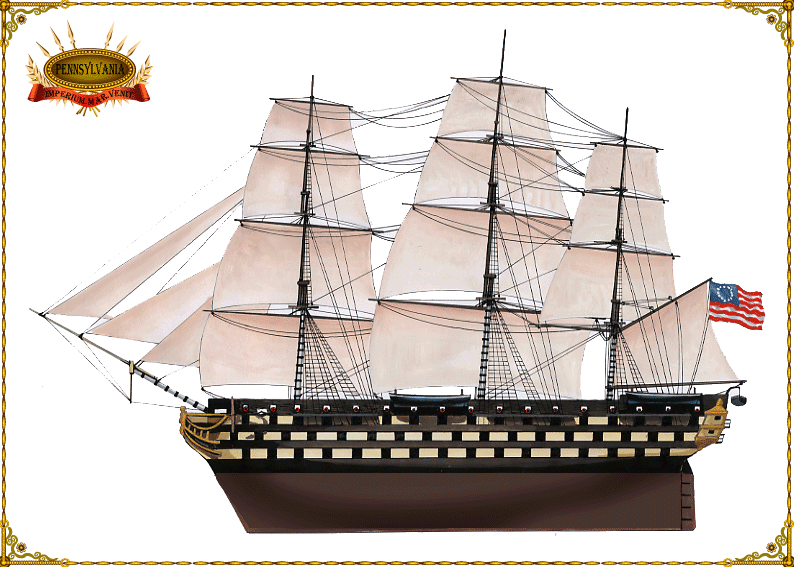
USS Pennsylvania was one of the classic tall ships of the line still in commission for the Union navy in 1860. This impressive man-o-war in the European tradition was launched in 1837 to meet equivalent units of the Royal Navy with which a conflict was still highly potent after 1812 war. She was the largest ship of the line ever commissioned on the American continent, at 3,105 tons, 120 guns, three full deck and an open one, surpassing all other other ships around 90 guns, two-deckers.
Displacement & dimension : 3,105 t ; 72 x 17,20 x 10.30 m
Propulsion: Sail only – 10-12 knots.
Wooden armor: 20-30 inches oak, teck
Armament: 120 guns from 25 to 50 pdr.
Crew: 850
USS MONITOR (1862)

She was sent to fought the CSS Virginia off Hampton Roads in March 1863, during what became the first naval battle of ironclads. The Hampton road battle was one heavily commented by the press, as beeing the chief naval duel between the two enemies in all the war. Despite the heavier armament of the Merrimack, the small and cramped monitor just turned around, remaining harmless.
CSS Viriginia at the same time, sustained no hits, the projectiles, fired at point-blank range, simply bounced off upon its metallic sloped flanks. Despite the success of the concept, the monitor was cramped, very bad seaboat, slow, and the turret could not fire too long as the detonation sound inside quickly rendered the guncrew deaf, and the smoke was just unbearable. The battle ended as a draw. However, the Monitor was never defeated. It simply capsized in port during a storm, the night of New Year 1863.
First in a long line, the revolutionary ship of John Ericsson was nicknamed “the cheese box on a raft.” The latter has had a hard time convincing the traditionalists Chiefs of Staff of the fleet of the merits of his riverine ironclad, the first with a unique Coles turret and two guns to bear. Built on the classic basis of the Mississippi packet boats, was ready in 1862, and commissioned after successful trials.
Displacement and dimensions : 987 t ; 52,42 x 12,64 x 3.20 m
Propulsion : Steam only, 2 Martin Boiler, 320 hp, 1 Ericsson screw – 6 knots.
Armour : 6 inches Iron riveted steel plates on oak framework
Armament : two 11 inches Dalghren RMLs guns.
Crew : 49
USS PASSAIC (1862)
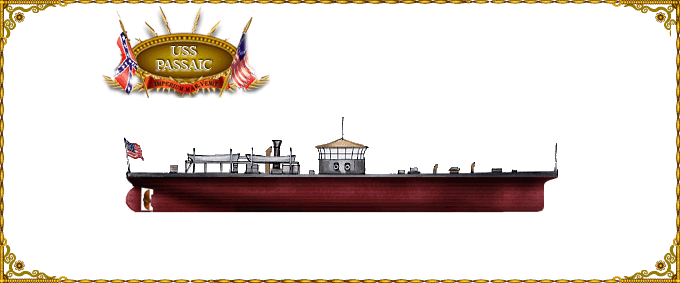
The USS Camanche was carried in parts by USS Aquila, which sank in 1863. Refloated and assembled, she entered too late in commission (May 1865) that it was transported in pieces by the USS Aquila, which sank in 1863. Transportation salvaged, reassembled, so it was put into operation later.
The USS Patapsco hit a mine in January 1865. The USS Wheekhaven sank due to an accidental filling of the purges in 1863. The survivors will be briefly reactivated as coastal monitors during the Spanish-American War of 1898.
This were ten improved “monitors”; lenghtened, widened, but with the same draught, and bearing one light and one heavyer guns, the first beeing used to help to targeting the first. The Passaic was the lead of file, they were launched between November 1862 and February 1863. They were heavily used for coastal and riverine operations until the end of the war.
Weight & dimensions : 1875 t ; 60,96 x 14 x 3.20 m
Propulsion : Steam only – 1 Ericsson screw, 4 Martin Boilers, 6 knots.
Armour : max 6 inches of iron plates on oak framework
Armament : Two Dalghren RMLs 15 and 8 inches guns.
Crew : 75
USS ROANOKE (1863)
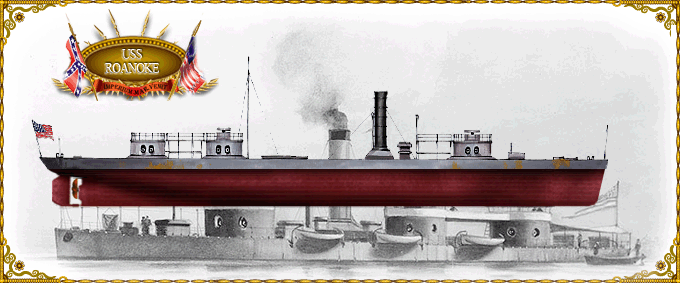
The ship was the first attempt to make a seagoing monitor. But it was overgunned. In fact the sheer topweight of the guns and turrets alike, combined with a too narrow, light hull, was a practical disaster, although the high freeboard was well suited for the moderate gale of the north atlantic.
The USS Roanoke was a great seagoing monitor, converted from the frigate of the same name, and bearing no less than three turrets. But the weight of the towers made it fairly unstable and therefore it was not used in operation, but remained at anchor as a coastal battery during her entire was commission and well after. It was hulked and and demolished in 1883.
Weight & dimensions : 4395 t ; 80,77 x 16,15 x 6,70 m
Propulsion : Steam only – 1 Penn trunk screw, 4 Martin Boilers, 6 knots.
Armour : Max 12 inches of iron plates on oak framework
Armament : Two 15 in, two 12 in, two 8 in Dalghren RMLs
Crew : 85
USS DICTATOR (1864)
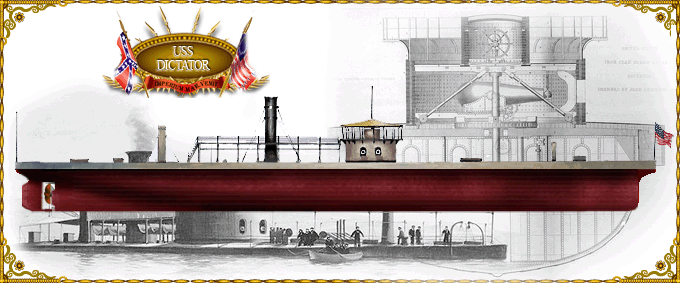
This seagoing monitor was built by Delamater Iron Works, New York, NY and commissioned in november, 11, 1864. She arrived too late to make a difference during the conflict, although her capacity to serve offshore gave her a distinct advantage for the years to come.
However, she has unrelentless machinery problems and was subsequently put out of commission for years, at League Island yard. In 1871 she was re-engineered and served with the north atlantic fleet at New York, before beeing decommissioned in 1883 and scrapped ten years later.
The largest monitor ever put into commission during the war, first named USS Protector, was a seagoing monster of nearly 5000 tons of wood and iron. As suggested by Ericsson, she was to be named Dictator, as a feared “republic sea monarch” of the united states. As designed, she has to carry two giant smoothbore 20 inches guns (510 mm), but the war urged a more standard gunnery, and stability was a concern.
Weight & dimensions : 4438 t ; 95 x 15 x 6,25 m
Propulsion : Steam only – 1 Penn trunk screw, 4 Martin Boilers, 10 knots.
Armour : Max 15 inches of iron plates on oak framework
Armament : Two 15 in Dalghren smoothbore RMLs
Crew : 174
USS MIANTONOMOH (1864)
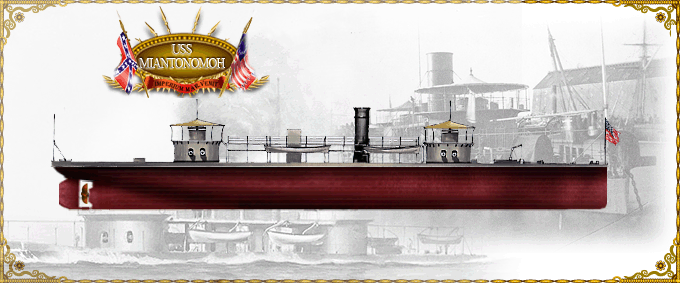
“Miantonomoh” was actually the name of the Narrangansett chief and son of the famous grand Sachem, Canonicus, also honored by another Monitor. These twin-screw ships were built at the New York Navy Yard, Brooklyn, New York, launched in 1863-64 and commissioned in 1865 for the North Atlantic squadron.
Seagoing and fast, as evidenced by the Miantonomoh cruise across the Atlantic in 1866, they were however decommissioned in 1874 after nine short years of service, but soon after beeing broken up, their scrap material was used to construct other monitors that were named after them, part of the Amphitrite class (1890).
The last monitors to be built during the war, the Miantonomoh class (from indian tribal names), were also the most costier ever. The Monadnock was in fact the only one to be commissioned soon enough to see then end of the war. The others were accepted into service between May and October 1865. The class of twin turrets, twin screws ships had four units, the Miantonomoh the Tonawanda, the Agamenticus and Monadnock.
Weight & dimensions : 3450 t ; 78,80 x 16 x 3,40 m
Propulsion : Steam only – 2 Ericsson screws, 4 Martin Boilers, 1400 hp, 10 knots.
Armour : Max 11 inches of iron plates on oak framework
Armament : Four 15 in Dalghren smoothbore RMLs (2×2)
Crew : 150
USS SPUYTEN DUYVIL(1864)
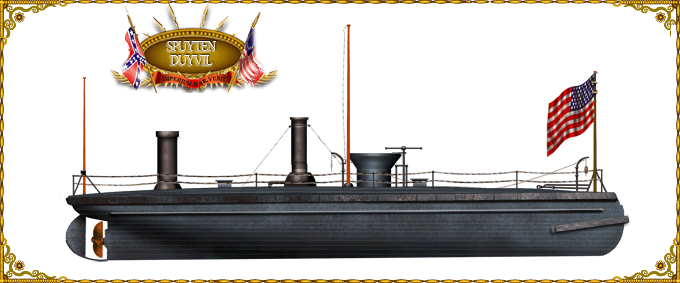
Built by SM Pook in june 1864, she was commissioned in november of the very same year. The Spuyten Duyvil (under the original name of USS Stromboli) had a partially armoured wooden hull, from 3in (decks) to 5in (sides), and 9in later on. On 25 november, she began to test its charges delivery system succesfully. She was put on action on the James River, blowing up obstruction ships under heavy enemy fire. However she never succeed to sunk any confederate ship, and after the war, used for various experiments until 1880.
This unusual ship was an experimental semi-submersible spar torpedo vessel. It was designd by William Hood, the chief engineer of the USN. It was an amazing ship with a nearly ten tons semi automatic watertight torpedo charge delivery system, with 12 charges in stores.
Weight & dimensions : 207 t ; 25,66 x 6,30 x 2,26 m
Propulsion : Steam only – 1 Ericsson screw, 1 Boiler, approx. 200 hp, 8 knots.
Armour : Max 9 inches of iron plates on wooden framework
Armament : 12 torpedo charges
Crew : 22
USS HARTFORD (1858)
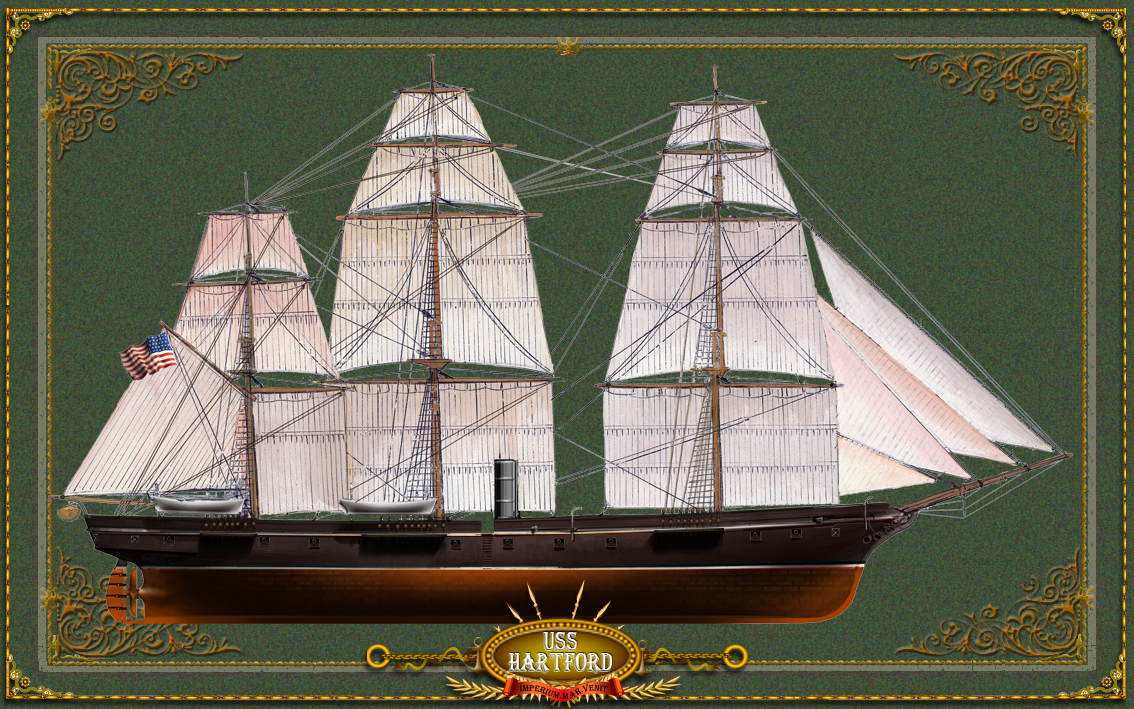
Launched in 1858 at Boston, she was the flasghip of the east indian squadron from 1858 to 1861 and came to Philadelphia in december when the war broke up. Then she was posted, under command of admiral Farragut between Ship Island and Mobile, trying to clean up the Mississippi mouth of Confederate ships.
Along with Porter’s mortar schooners she succesfully cut the chains protected the entrance of the mouth and silenced many southerner guns positions during the night of april, 16, 1862. She dodged and fought back successfully CSS Manassas and bombed the unfinished CSS Louisiana.
Later she ended the confederate batteries, and threaten to surrender Baton Rouge and Natchez, and in june 1863 she was one of the ship shelling the city of Vicksburg. She distinguished herself in august 1864 at the battle of Mobile Bay and 12 sailor of her crew earned the Congress Medal of Honor for exceptional gallantry.
After the war she undertook a long career in the pacific and was ultimately unlisted in 1926. She was to be undertaken for refitting and be shown as musem ship, but left instead in Norfolk to rot until 1956 when what left of her sank and had to be dismantled.
The USS Hartford was one of the six screw corvettes of war of the Union Navy in 1861, and became the most famous. This 24 gun ships earned fame during the battle of Mobile bay, New Orleans battle and Vicksburg siege…
Weight & dimensions : 2250 t ; 69 x 13 x 5,23 m
Propulsion : 1 lifting screw, 9,5 knots and 13.5 under sail.
Armour : Extra planking on Wooden framework
Armament : 20x9in Dalghren SB guns, 2x20pdr Parrots Rifles, 2x12pdr.
Crew : 302
USS TICONDEROGA (1862)
![]()
There were two classes of barque-rigged sloops, Sacramento and Ticonderoga if the Sacramento class (Sacramento, Monongahela, Canandaigua, Shenandoah) laid down in 1861 and completed from august 1862 to june 1863, and Ticonderoga class (Ticonderoga and Lackawanna) completed in january and march 1863.
The first were essentially a lnghtened version of the ossipee, while the latter were lenghtened versions of the Sacramento (and 420 tons heavyer). All were barque-rigged, one-funneled with same arrangement, but considerable variation in gunnery.
Most of them fought at Mobile bay, all survived the war, Sacramento beeing wrecked on uncharted reefs o the indian coast in 1867 and the others sold in 1884-1887, although Monongahela, which attempted to pass Port Hudson, was converted to a sailing supply, training and storage in 1883, surviving until 1908 were she was burnt at Guantanamo bay.
The USS Ticonderoga was a wooden screw sloop of war, along with USS Lackawanna were similar to a six ships class (Sacramento class), most of them fightning at Mobile bay.
Weight & dimensions : 2526 t ; 71,43 x 11,63 x 4,95 m
Propulsion : 1 lifting screw, 10,5 knots.
Armour : Extra planking on Wooden framework
Armament : 1×4.2in Parrott RML, 12x9in SB, 2x7in Parrots Rifles.
Crew : 270
USS HOUSATONIC (1861)
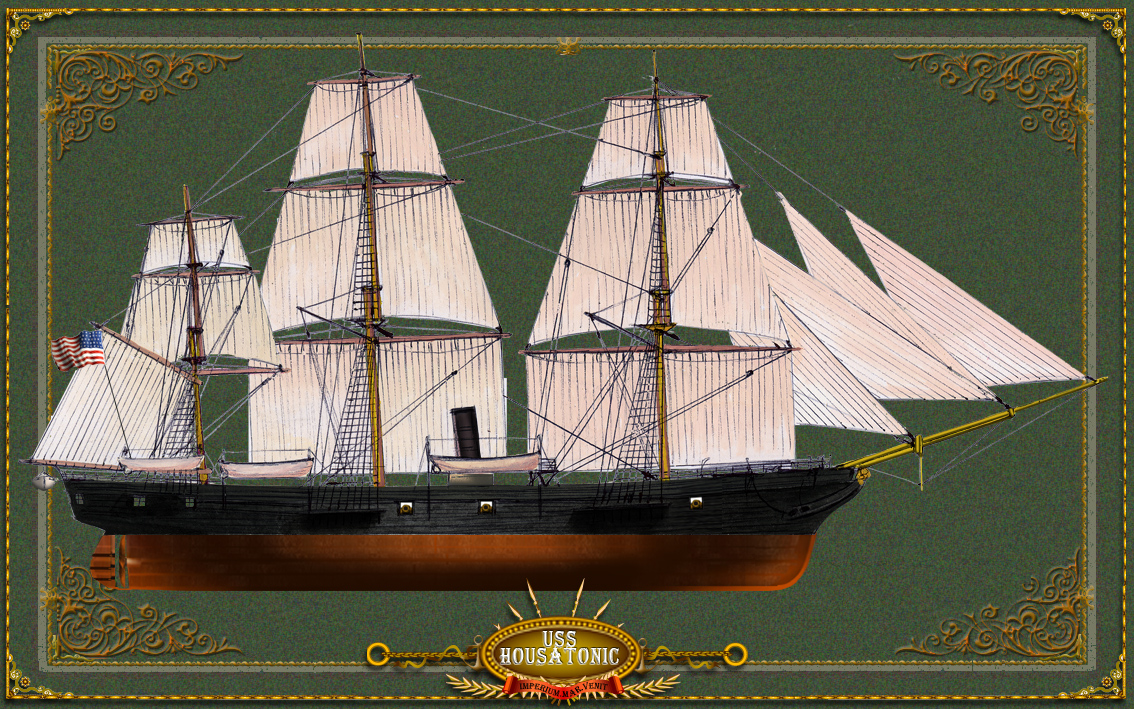
The USS Housatonic was launched in november 1861 at Boston naval yard. She was part of the four Ossipee class wooden screw sloops, also with USS Adirondack (wrecked on the little Bahama bank), Ossipee and Juniata. Ossipee fought at Mobile bay. Both Ossipee and Juniata served until 1891, beeing modernised and rearmed in 1887.
USS Housatonic was sunk by a spar torpedo manned by the crew of the HL HUNLEY, a confederate submarine. It was the very first submarine victory in history.
The USS Housatonic was a wooden screw sloop, part of the Ossipee class of four ships. Housatonic was the very first ship ever to be sunk by a submarine, the HL Hunley in august 1862.
Weight & dimensions : 1934 t; 62,48 x 11,58 x 5,02 m
Propulsion : 1 screw, 10 knots.
Armour : Extra planking on Wooden framework
Armament : 1×6.4in Parrott RML, 3×4,2in Parrott RML, 1x11in SB, 2x32pdr SB.
Crew : 214
USS New Ironsides (1862)
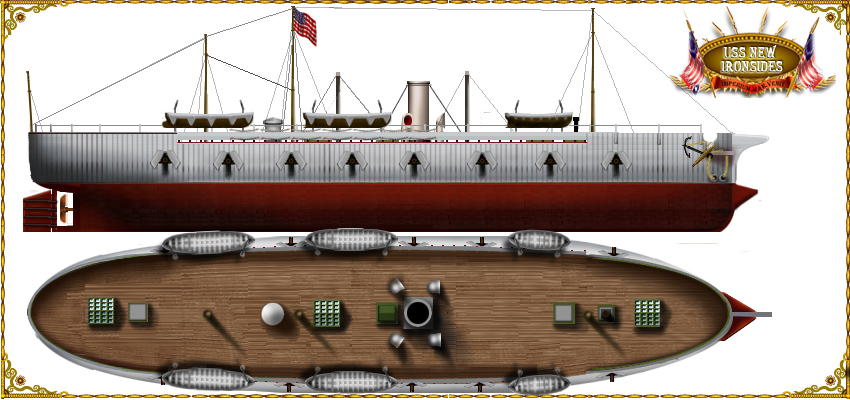
The first USN sea-going ironclad was launched in may 1862 at Philadelphia. She fought at Hampton roads, successfully repelled confederates attacks, in the North and South Atlantic Blockading Squadron, bombarded forts and confederates positions taking many hits without fatalities.
She was torpedoed twice, the first time in april 1863, and later with CSS David i, december. After rebuilding, she took part in many other engagements but never encountered a real opponent. She took fire in 1866 while on moorings at Philadelphia and was lost.
The USS New ironsides was the first seagoing ironclad of the US Navy, designed to deal with Virginia and other confederate ironclads. She was torpedeoed by CSS David in december 1863 and entirely rebuilt (picture).
Weight & dimensions : 4120-4190 t; 70,10 x 17,5 x 4,8 m
Propulsion : 1 screw, 1800 hp, 7 knots.
Armour : Wooden hull-iron plating from 1in to 4,5in
Armament : 14x11in Dalghren RML, 2×150 pdr Parrott rifles, 2×60 pdr Dalghren rifles.
Crew : 449

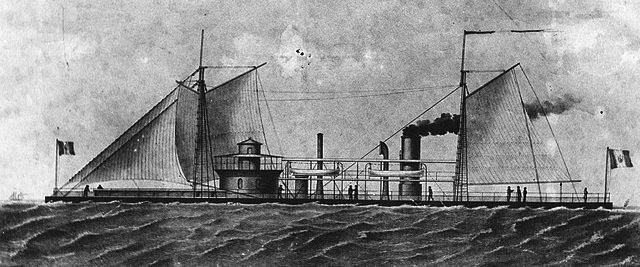
 Latest Facebook Entry -
Latest Facebook Entry -  X(Tweeter) Naval Encyclopedia's deck archive
X(Tweeter) Naval Encyclopedia's deck archive Instagram (@navalencyc)
Instagram (@navalencyc)





 French Navy
French Navy Royal Navy
Royal Navy Russian Navy
Russian Navy Armada Espanola
Armada Espanola Austrian Navy
Austrian Navy K.u.K. Kriegsmarine
K.u.K. Kriegsmarine Dansk Marine
Dansk Marine Nautiko Hellenon
Nautiko Hellenon Koninklije Marine 1870
Koninklije Marine 1870 Marinha do Brasil
Marinha do Brasil Osmanlı Donanması
Osmanlı Donanması Marina Do Peru
Marina Do Peru Marinha do Portugal
Marinha do Portugal Regia Marina 1870
Regia Marina 1870 Nihhon Kaigun 1870
Nihhon Kaigun 1870 Preußische Marine 1870
Preußische Marine 1870 Russkiy Flot 1870
Russkiy Flot 1870 Svenska marinen
Svenska marinen Søværnet
Søværnet Union Navy
Union Navy Confederate Navy
Confederate Navy Armada de Argentina
Armada de Argentina Imperial Chinese Navy
Imperial Chinese Navy Marinha do Portugal
Marinha do Portugal Mexico
Mexico Kaiserliche Marine
Kaiserliche Marine 1898 US Navy
1898 US Navy Sovietskiy Flot
Sovietskiy Flot Royal Canadian Navy
Royal Canadian Navy Royal Australian Navy
Royal Australian Navy RNZN Fleet
RNZN Fleet Chinese Navy 1937
Chinese Navy 1937 Kriegsmarine
Kriegsmarine Chilean Navy
Chilean Navy Danish Navy
Danish Navy Finnish Navy
Finnish Navy Hellenic Navy
Hellenic Navy Polish Navy
Polish Navy Romanian Navy
Romanian Navy Turkish Navy
Turkish Navy Royal Yugoslav Navy
Royal Yugoslav Navy Royal Thai Navy
Royal Thai Navy Minor Navies
Minor Navies Albania
Albania Austria
Austria Belgium
Belgium Columbia
Columbia Costa Rica
Costa Rica Cuba
Cuba Czechoslovakia
Czechoslovakia Dominican Republic
Dominican Republic Haiti
Haiti Hungary
Hungary Honduras
Honduras Estonia
Estonia Iceland
Iceland Eire
Eire Equador
Equador Iran
Iran Iraq
Iraq Latvia
Latvia Liberia
Liberia Lithuania
Lithuania Mandchukuo
Mandchukuo Morocco
Morocco Nicaragua
Nicaragua Persia
Persia San Salvador
San Salvador Sarawak
Sarawak Uruguay
Uruguay Venezuela
Venezuela Zanzibar
Zanzibar Warsaw Pact Navies
Warsaw Pact Navies Bulgaria
Bulgaria Hungary
Hungary

 Bundesmarine
Bundesmarine Dutch Navy
Dutch Navy Hellenic Navy
Hellenic Navy Marina Militare
Marina Militare Yugoslav Navy
Yugoslav Navy Chinese Navy
Chinese Navy Indian Navy
Indian Navy Indonesian Navy
Indonesian Navy JMSDF
JMSDF North Korean Navy
North Korean Navy Pakistani Navy
Pakistani Navy Philippines Navy
Philippines Navy ROKN
ROKN Rep. of Singapore Navy
Rep. of Singapore Navy Taiwanese Navy
Taiwanese Navy IDF Navy
IDF Navy Saudi Navy
Saudi Navy Royal New Zealand Navy
Royal New Zealand Navy Egyptian Navy
Egyptian Navy South African Navy
South African Navy






























 Ukrainian Navy
Ukrainian Navy dbodesign
dbodesign
that’s it?
That’s a fairly old introduction planned to be completed it one day. There’s a team to join if you see fit. Plenty of ships and battles to cover… Be my guest.